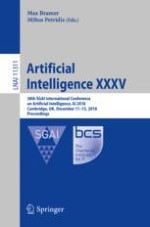2018 | OriginalPaper | Chapter
A Brain-Inspired Cognitive System that Mimics the Dynamics of Human Thought
Authors : Yuehu Ji, David Gamez, Christian Huyck
Published in: Artificial Intelligence XXXV
Publisher: Springer International Publishing
Activate our intelligent search to find suitable subject content or patents.
Select sections of text to find matching patents with Artificial Intelligence. powered by
Select sections of text to find additional relevant content using AI-assisted search. powered by
